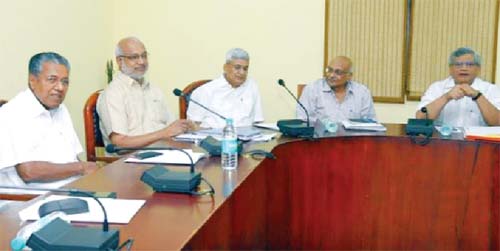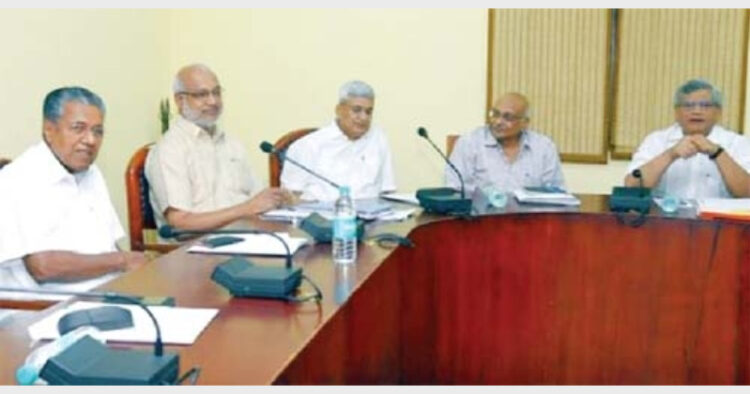The confusing signals given by the Politburo meeting in the last week of May are grand enough to cast doubts about the future of CPM as a national party and its ability to mend ways with the changing times
Dipin Damodharan
 Substance must follow grandiloquent ideology, and unfortunately for CPM, it has very little substance to show for their efforts to raise the cause of the common man. It has reached a crucial point where the act of survival meets the final stage of compromising its identity. What will be the next stage? We may simply stand and watch the party withering away even further. Ironically, or say incidentally, there was a concept called ‘withering away of the state’ in Marxism, coined by German social scientist Friedrich Engels, which refers to the idea that, with realisation of the ideals of socialism, the social institution of a state will eventually become obsolete and disappear, as the society will be able to govern itself without the state and its coercive enforcement of the law. Withering away of the state can be replaced by the concept withering away of the party in the Indian context…but a rider, totally contrary to what Engels said, because the communists have never reached such a stage in India as envisioned by the social thinker.
Substance must follow grandiloquent ideology, and unfortunately for CPM, it has very little substance to show for their efforts to raise the cause of the common man. It has reached a crucial point where the act of survival meets the final stage of compromising its identity. What will be the next stage? We may simply stand and watch the party withering away even further. Ironically, or say incidentally, there was a concept called ‘withering away of the state’ in Marxism, coined by German social scientist Friedrich Engels, which refers to the idea that, with realisation of the ideals of socialism, the social institution of a state will eventually become obsolete and disappear, as the society will be able to govern itself without the state and its coercive enforcement of the law. Withering away of the state can be replaced by the concept withering away of the party in the Indian context…but a rider, totally contrary to what Engels said, because the communists have never reached such a stage in India as envisioned by the social thinker.
The Indian Communist Party officially started functioning in 1925, incidentally the same year the Hindutva movement assumed a new shape in the form of the RSS (Rashtriya Swayamsevak Sangh). It has been more than nine decades now since India witnessed the entry of the Communist Party and the RSS. A comparison between two of India’s most effective cadre-based organisations has little scope as the latter one has expanded its influence in almost all fields of Indian society. The former one missed the bus because of their miscalculation on fitting an alien ideology to India’s complex social structure. And, there’s no logic in doing a comparison at this point of time. The question that arises at this juncture is about the grave erosion of the support base of CPM. It has become more evident in most of the recent Assembly and Parliament elections as the people fail to identify the party with them.
The latest in the lineup was the West Bengal Assembly election, which was a terrible disaster for the Party in a state which once hyped as the bastion of the Communists. Of course, the Party clinched power in Kerala with absolute majority as it went for a PR blitzkrieg to take on Oommen Chandy-led Congress. But the ironies of ideology gained momentum. The CPM-win in Kerala, the Bengal debacle, and the Politburo meeting in the last week of May are grand enough to cast doubts about the future of CPM as a national party with core communist values. Why? The answer lies in the joint venture between CPM and Congress in Bengal despite a long history of animosity between two parties.
For CPM, the assembly election was a critical step in reacquiring its base in the state, but no lessons were learnt. It was in 1967 the CPM faced its first electoral test in West Bengal, and won 43 Assembly seats then. And in 2016, the Party has been reduced to 26 seats in the state where it ruled uninterruptedly for 34 years. Instead of changing its strategy to restore its relevance, they thought electoral gains would be achieved by cozying up with Congress as the domineering Trinamool Congress had become an unbeatable force in the state. As politics is the art of electoral possibilities, the comrades have no comments on the tough battle between Congress and the Left in Kerala. In Bengal, the Communist ideology of anti-globalisation and anti-liberalism can match up with Congress’ crony-capitalism and feudal line of thoughts, no issues. And in Kerala, the CPM fights against capitalist Congress, the Party which was engaged in implementing the neo-liberal policies of Dr Manmohan Singh-inspired economists. In Kerala, the Congress is a synonym for corruption, and in Bengal the same Congress becomes a solution for CPM’s alienation. The act of political survival doesn’t seem to be logical always. As veteran communist leader Somnath Chatterjee observed that CPM-Congress alliance in Bengal is not a political option but a necessity. Read the term necessity as the act of electoral survival here.
The decision to team up with the Congress was not approved by a section in the Politburo, and the Central leadership directed the Bengal unit to decide on the matter. Then what? The result was a terrible electoral debacle which paved the way for an extreme situation where the Party is clueless about how to move forward. In the 2011 elections, Trinamool Congress had 39 per cent vote share in the state, and that was equal to the combined vote shares of the Congress and Left. Look at the vote share percentages of 2016 election. TMC secured 44.9 per cent votes to claim 211 of 294 seats, and the Left-Congress joint venture got 39 per cent vote share. The results offered the Karat-supporters some good stuff to blame Party general secretary Sitaram Yechury, the main force behind the pre-poll alliance. Many political pundits think that what Yechury did was a political blunder in his career as the Party chief. “CPI went into terminal decline when it compromised with the Congress in 1969-1970. In 2016, CPM is being destroyed because it abandoned principles in search of a cheap return ticket to power,” wrote eminent journalist M J Akbar in the Indian Express. But the comrades in the Bengal unit are not ready to sing this tune. They are damn clear that the Party needs an understanding with the Congress to move on in the state. According to them, the central leaders are not able to sense the mood of the cadres in the state.
Now, let us come to the point I mentioned at the beginning. The withering away of the Party, not the state! The Politburo of the CPM met at New Delhi on May 29 and 30. The Party statement on Assembly elections goes like this, “With regard to the electoral tactics pursued by the CPM in various states, the electoral tactics evolved in West Bengal was not in consonance with the Central Committee decision based on the political-tactical line of the Party which states that there shall be no alliance or understanding with the Congress party.” It is the Prakash Karat line. Yechury still thinks that a united struggle with the Congress is needed to counter Mamata Banerjee’s Trinamool Congress. According to reports, the CPM’s Bengal unit is not ready to follow this diktat. Political experts are of the understanding that the Party has already come to an informal understanding with the Congress about the alliance. Despite the official party line, there will be an electoral alliance between the Congress and Left at least till the 2018 State Panchayat elections in Malda.
Regardless of the Party’s official stand, the Bengal unit seems to be going ahead with what they called tactical alliance with the Congress. But, what does it mean for a normal party worker. Here, the normal party cadres are becoming totally clueless about what’s their stand on the Congress. The last Politburo meeting on May 30 made the issue worst. Now the air is filled with contrary statements from leaders at the top. Things have reached at a point where the Party seems to lose its control over the structure.
(The writer is editorial Head of ‘Future Kerala Business Daily’)













Comments